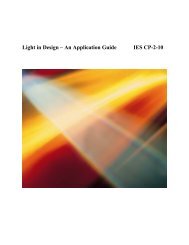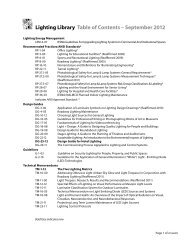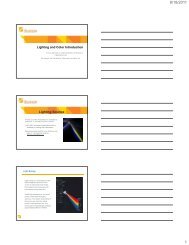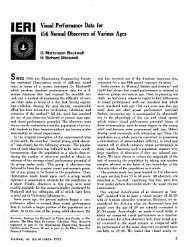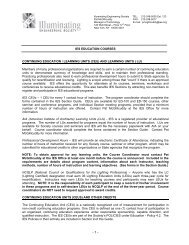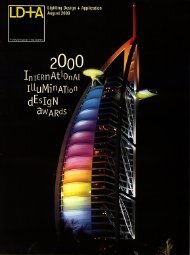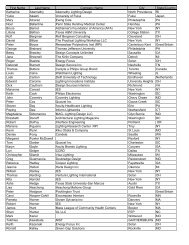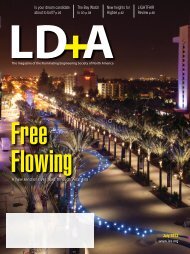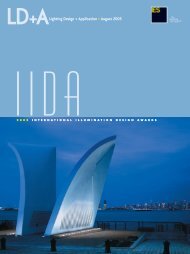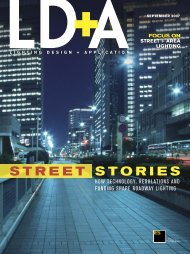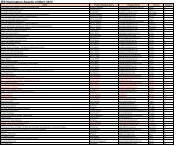light products - Illuminating Engineering Society
light products - Illuminating Engineering Society
light products - Illuminating Engineering Society
You also want an ePaper? Increase the reach of your titles
YUMPU automatically turns print PDFs into web optimized ePapers that Google loves.
RESEARCH MATTERS<br />
research results to roadway and automobile<br />
<strong>light</strong>ing practice, it is necessary<br />
to quantify a driver’s task load under<br />
different roadway characteristics (e.g.,<br />
highways, interchanges, or curves) by<br />
using a standard detecting task such<br />
as one used by MacDonald and Ellis<br />
(1975).Finally,it is important to determine<br />
<strong>light</strong>ing requirements for each of<br />
the roadway characteristics while taking<br />
into account the influence of task<br />
load on detection performance. The<br />
evidence so far indicates that such<br />
understanding would help us to make<br />
our roadways safer.<br />
References<br />
Akashi Y, Rea MS, 2002. Peripheral<br />
detection while driving under a<br />
mesopic <strong>light</strong> level, Journal of the<br />
<strong>Illuminating</strong> <strong>Engineering</strong> <strong>Society</strong>, 31, 1,<br />
85-94<br />
Akashi Y, Neches J, 2003.The effect<br />
of foveal task load on peripheral target<br />
detection, Proceedings of CIE 25th<br />
Session in San Diego, D4, 44-47<br />
Bullough J, Rea MS, 2000. Simulated<br />
driving performance and peripheral<br />
detection at mesopic <strong>light</strong> levels,Lighting<br />
Research and Technology, 32, 4, 194-198<br />
He Y, Rea MS, Bierman A, Bullough<br />
J, 1997. Evaluating <strong>light</strong> source efficacy<br />
under mesopic conditions using reaction<br />
times, Journal of the <strong>Illuminating</strong><br />
<strong>Engineering</strong> <strong>Society</strong>, 26, 1, 125-138<br />
Harms L, 1986. Drivers’ attentional<br />
responses to environmental variation:<br />
a dual-task real traffic study, In Gale<br />
AG et al.Vision in Vehicles II,Amsterdam:<br />
Elsevier Science Publishers, 131-138<br />
Johnson A, Proctor RW, 2004.<br />
Attention:Theory and Practice,Thousand<br />
Oaks,CA:Sage Publications,Inc.,30-37<br />
MacDonald, Ellis, 1975. Driver<br />
workload for various turn radii and<br />
speeds, Proceedings of the annual<br />
Meeting of the Transportation Research<br />
Board,Washington, D.C.<br />
Navon D,Miller J,2002.Queuing or<br />
sharing A critical evaluation of the<br />
single-bottleneck notion. Cognitive<br />
Psychology, 44, 193-251<br />
Pashler HE, 1998. The psychology of<br />
attention, Cambridge, MA: MIT press<br />
Teichner WH, Krebs MJ, 1972.<br />
Laws of the simple visual reaction<br />
time, Psychological Review, 79, 344-358<br />
Treat JR,Tumbas NS, McDonald ST,<br />
Shinar D, Hume RD, Mayer RE,<br />
Stansifer RL, and Castellan NJ, 1977.<br />
Tri-level study of the causes of traffic<br />
accidents, Report No. DOT-HS034-3-<br />
535-77.<br />
Verwey WB, 1993. How can we<br />
prevent overload of the driver<br />
Oarkes AM, Franzen S, Driving future<br />
vehicles,London:Taylor & Francis,235-<br />
244.<br />
Vince M, 1949. Rapid response<br />
sequences and the psychological<br />
refractory period, British Journal of<br />
Psychology, 40, 23-40<br />
Welford AT, 1952. The psychological<br />
refractory period and the timing<br />
of high speed performance-A review<br />
and a theory. British Journal of<br />
Psychology, 43, 2-19<br />
RP-1<br />
1/2 horiz<br />
12 www.iesna.org



